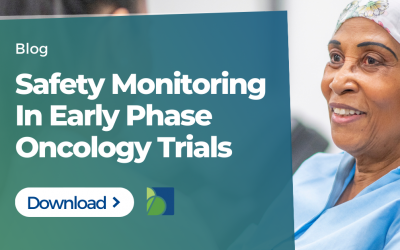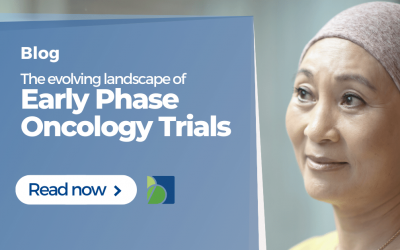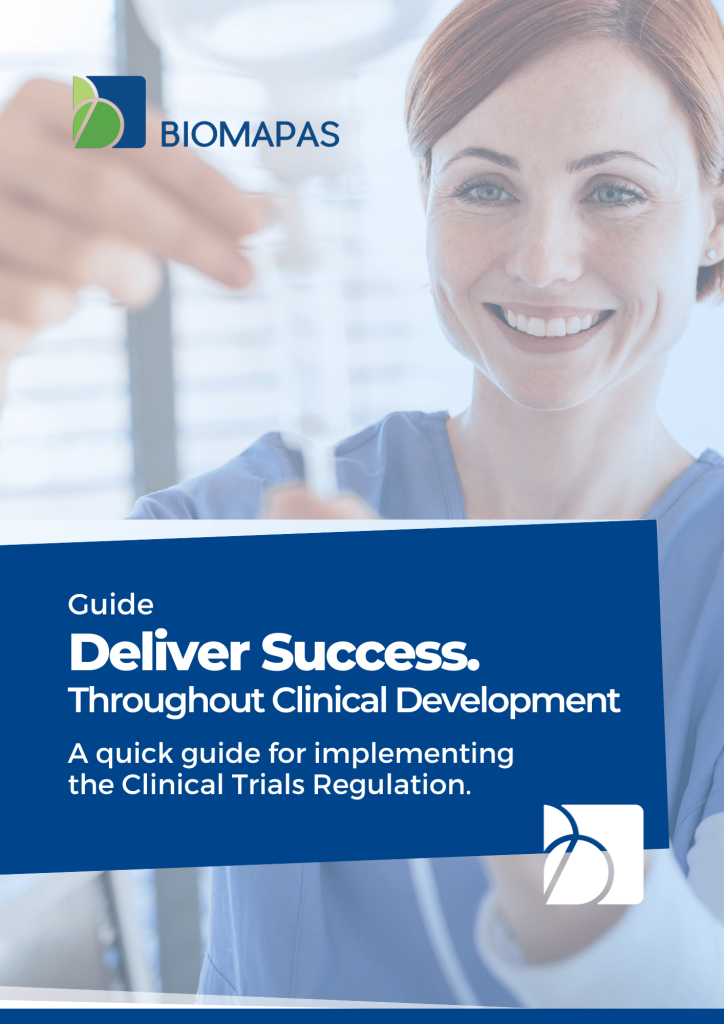
Designing effective early-phase oncology trials is a complex and challenging task, requiring careful consideration of various factors, including patient selection, dosing, safety monitoring, and endpoint selection. In addition, developing targeted therapies has brought new challenges and opportunities to early-phase oncology trial design. In this article, we will discuss the influence of these developments on the clinical trial design of early-phase oncology studies.
Fundamental changes in Early Phase Oncology
Cancer remains one of the most pressing health challenges worldwide, and developing new and effective therapies is critical for improving patient outcomes. Clinical trials are a crucial component of the drug development process, providing the data needed to determine the safety and efficacy of new treatments. Early-phase clinical trials, typically the first-in-human studies of a new drug, are essential for oncology drug development.
Over the last two decades, oncology has seen some fundamental transformations. Innovative approaches for targeting tumours have been developed, including immunotherapy and molecularly targeted agents. As the mechanisms of action of these agents differ from traditional cytotoxic agents, the design of early-phase oncology trials that assess the safety and efficacy of these agents also requires a different approach. In addition, new insights from (Bayesian) statistics have been increasingly implemented in clinical trial design. Additionally, it has become more common to combine different therapies. Finally, there is a trend to offer personalized treatment, with the optimal therapies being selected on biomarkers specific to the patient or the tumour type.
New therapy types in Early-Phase Oncology Clinical Trials
Cancer is classically treated with a combination of surgery, radiotherapy and chemotherapy. Nowadays, a more diverse range of therapies is available or being developed, including molecularly targeted agents and cell and gene-based therapies (CGT). Examples of CGTs are immunotherapy with chimeric antigen receptor (CAR) T-cells or intratumoural injection with an oncolytic virus. These novel therapy types have different mechanisms of action than cytotoxic drugs, with important implications for determining the maximum tolerated dose (MTD) and the optimal dose.
For cytotoxic agents, the general assumption is that both efficacy and toxicity increase with higher doses. Therefore, the MTD is determined based on the proportion of patients in a phase I trial that experience dose-limiting toxicities (DLTs). DLTs are defined in the trial protocol and are typically monitored in the first cycle of a phase I trial, which usually lasts 28 days. Therefore, the MTD found in a phase I oncology trial is often the recommended dose for a phase II trial. However, adverse events are not always acute, especially for immunotherapy, and there may be late-onset adverse events that occur outside of the short-term monitoring period. A solution for this is to extend the evaluation period for DLTs. Additionally, more rich data on toxicity can be incorporated into the trial design, for example, through the time-to-event continual reassessment method (TITE-CRM) (we’ll discuss more details about the CRM in the next section).
Also for efficacy, the general assumption of a higher dose resulting in higher anti-tumour activity should not simply be made for novel therapy types. Anti-tumour activity is often seen to increase at lower doses and plateau at higher doses, whereas DLTs might still increase with the doses. For this reason, clinical trial designs often have two endpoints: a toxicity endpoint and a tumour activity endpoint, intending to determine the optimal biological dose (OBD). Biomarkers are often used to determine the OBD, such as specific blood plasma levels, immunological parameters and bioassays.
Adaptive Oncology Clinical Trial Design
Traditional phase I oncology trial designs are often rule-based. Usually, the MTD is determined through dose escalation cohorts (DECs). For example, in a standard 3×3 design, small cohorts of three subjects are treated with a starting dose, and if no DLTs are detected, another cohort is treated with an increased dose. This process continues until DLTs occur and are confirmed in another cohort. However, it is known that this design often leads to an under- or overestimation of the MTD, thereby contributing to high trial costs and the failure rate of oncology trials. A more modern rule-based trial design is the modified toxicity probability interval (mTPI), which makes assumptions about underdosing, equivalence and overdosing intervals based on prior knowledge, and which anticipates the detection of adverse events.
BOIN Designs for Early Phase Oncology
Furthermore, the Bayesian optimal interval (BOIN) design defines intervals for DLTs based on prior knowledge and follows a rule-based dose-escalation design. mTPI and BOIN designs are particularly useful when relatively few dose levels are expected to be tested. There are several webtools available to help with the (statistical) planning of mTPI and BOIN designs. mTPI and BOIN designs do not fully use all toxicity data from all cohorts for decision-making.
Contrinual Reassessment Method (CRM) for Early Phase Oncology
Another Bayesian approach that does this is the continual reassessment method (CRM). In a CRM design, each trial subject is weighted by the proportion of the observation period that the subject was observed, and the accumulated data from all subjects and cohorts are included for each decision point. This way, the model that predicts the occurrence of DLTs is continuously adjusted, allowing the trial design to be modified. CRM is statistically more complex than traditional or mTPI, or BOIN designs, and planning assistance by a statistician is advisable. However, it is the most flexible form of clinical trial design, and it is often shown to be more accurate than rule-based designs.
Building flexibility Into Your Trials
Flexible clinical trial designs allow for adjustments to, for instance, the dose, cohort sizes and patient selection criteria. These potential modifications have to be pre-defined in the trial protocol. With this flexibility, adaptive designs can accelerate trial performance, reduce costs, and gather more accurate data, thereby decreasing the failure rate of early-phase oncology trials. Regulators also encourage implementing adaptive trial designs and have drafted guidance for this, including the FDA and European Union. For example, regulators often require simulation data of the Bayesian models used for clinical trial design.
Combination Oncology Clinical Trials
It is common to combine several drug therapies for treating cancer. Trials assessing the efficacy of these combinations are particularly complex. The MTD or OBD that has been established in a monotherapy trial cannot just be implemented in a combination trial. Because various combinations with different doses are possible, multiple MTDs and OBDs can be possible. Therefore, new dose escalation cohorts must be examined to explore the optimal doses for combination therapies. As the number of possible combinations and the related costs can snowball rapidly, the benefits of adaptive trial design again become evident. For example, CRM designs use models based on prior knowledge from monotherapy trials, PK/PD data and other information sources. This allows you to predict which dose combinations are most likely to succeed and should therefore be selected for testing.
Umbrella Trials, Basket Trials & Platform trials
Special types of trials are umbrella, basket and platform trials. In a basket trial, a single therapy is tested on several tumour types. This is an interesting approach if a similar molecular alteration is known to underly different tumour types. If early phase trials show promising safety and efficacy data in one or more tumour types in a basket trial, you can decide to continue clinical trials with those tumour types and discontinue testing others.
Importantly, Bayesian modelling in an adaptive trial design will enable the use of toxicity and efficacy data across cohorts for different tumour types. In an umbrella trial design, several therapies (or combinations of therapies) are tested on the same tumour type. This allows for direct comparison with alternative treatment options. Moreover, a common control group can be used for the different therapy/combination options. Finally, platform trials can test multiple therapies in multiple tumour types and are the most complex type of design.
Although complex to plan, the flexibility of these trial designs can provide benefits when carefully planned. Regulators typically require a master protocol for these complex designs, where all details, including endpoints, stopping rules and expansion possibilities, are defined. This includes rules for continuing one trial arm if certain criteria are met or discontinuing another if adverse events are detected, efficacy is insufficient, or if another treatment (combination) is more promising. It also allows the enrolment of patients into a single study and moving patients to the most promising treatment option. This is beneficial for both the study and the patient. It can also save time and clinical development costs. In fact, an analysis by Deloitte has shown that using a master protocol can reduce overall clinical trial costs by 10-35%.
Personalization
In modern medical practice, cancer treatment is more and more personalized. This is also reflected in the design of early-phase oncology trials. For instance, a tumour’s molecular and/or genetic profile is often used to determine which treatment option is most promising. Particularly in basket trials, patients’ individual biomarkers are used as inclusion criteria. Therefore, to enable a personalized approach, it is important to select trial sites with adequate bioanalytical facilities to measure a range of biomarkers.
Concluding Remarks for Early Phase Oncology Clinical Trials Design
For the effective design of early-phase oncology trials, it is crucial to keep several factors in mind. First, the drug’s or therapy’s mechanism of action is important. CBT or molecularly targeted agents have less predictable dose-toxicity and dose-efficacy relationships than traditional cytotoxic drugs. The number of doses that are expected to be tested, and a potential combination with other oncology therapies, influence the trial design choice. Often, an adaptive design is beneficial, of which a continual reassessment method usually offers the most benefits. The complexity increases when drug combinations are tested or when, for instance, basket or umbrella trials are desirable. On the other hand, too complex designs also can leave many things open for interpretation, ultimately costing time and money. It is advisable to work with a CRO with both clinical and statistical design expertise and a network of clinical trial sites that offer the necessary technological facilities.
Webinar: Exploring Oncology Clinical Design
Join us for an engaging and educational webinar on the topic of “Exploring Oncology Clinical Design”. This webinar will provide you with valuable insights and the latest information on oncology clinical design.
Safety Monitoring in Early Phase Oncology Trials: Key Points to Consider
For all clinical trials, it is crucial that the potential benefits of a medicinal product are determined, while monitoring any potential side effects. However, for early-phase oncology trials, the extensive monitoring of adverse events (AEs) is essential, considering...
Oncology Study Design
Join us for a must-attend webinar on “Exploring Oncology Clinical Trial Design”, where expert speakers will share the latest insights.
How Do Early Phase Oncology Trials Evolve?
In the last few years, a major breakthrough in cancer research has occurred: early phase oncology trials. This type of trial is designed to test whether a new drug has any adverse effects on people and also provides anecdotal evidence that it might be efficacious....









